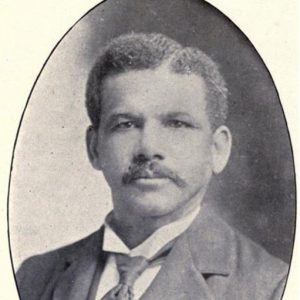calsfoundation@cals.org
Josiah Homer Blount (1860–1938)
Josiah Homer Blount was a successful African American businessman who, in 1920, became the first Black person to run for governor of Arkansas.
Josiah Blount (sometimes referred to as Professor, J. H., or John) was born in slavery on September 17, 1860, to farmers Madison Blount and Queen Victoria Isabella Lester Blount in Clinton, Georgia. David E. Blount was their white master. After the Civil War and Emancipation, Blount was given a good education in public schools. He graduated from the now-defunct historically black college known as Central Tennessee College (later Walden College/University), which was founded for freedmen in 1865 in Nashville, Tennessee; Meharry Medical College grew from this school.
In 1892, Blount married Justina Almyra Payne. She was an exceptional school teacher for over thirty years and a homemaker. They had three children: Josiah Homer Blount Jr., Scott Bond Blount (named after Blount’s best friend Scott Bond), and Geraldine L. Blount (later Geraldine Johnson).
Blount was a teacher, principal, and education administrator for more than forty years. He taught in four cities in Arkansas: Texarkana (Miller County), Hot Springs (Garland County), Helena (Phillips County), and Forrest City (St. Francis County). He was also a successful farmer. He used mostly sharecroppers to work the vast amounts of land that he leased and the 400 acres that he owned close to his home, which remain in the family in the twenty-first century. In 1912, he helped establish a park for African Americans at the corner of Linden and Scull Streets in Pine Bluff (Jefferson County).
In 1917, while teaching in Forrest City, Blount also became a master brick maker, managing a brick factory in Forrest City for a Mr. Gray. Blount taught Scott Bond how to make bricks and helped Bond build a brick manufacturing plant in Forrest City.
Blount was chairman of the St. Francis County Republican Committee in 1920. He was also the superintendent of “colored schools” in Forrest City and wanted to run for governor as the Republican candidate, being a lifelong Republican supporter. However, Blount and all of his Black supporters were prevented from attending the Republican Convention in Little Rock (Pulaski County) by the “lily-white” faction of the party, who held their convention at the segregated Marion Hotel. This action made it impossible for Blount to get the Republican Party’s nomination. At the Mosaic Templars of America headquarters on the corner of Ninth Street and Broadway in Little Rock, Black Republicans started their own party faction called the “Black and Tans,” and Blount was chosen as their candidate for governor.
The gubernatorial election was held in 1920, and Democrat Thomas Chipman McRae won the election in a landslide with 123,604 votes (65 percent). Wallace Townsend, the white Republican candidate, received 46,339 votes (24 percent). Townsend had also been the Republican gubernatorial nominee in 1916, losing to the Democrat Charles Hillman Brough. Blount was forced by Secretary of State Thomas Jefferson Terral to run as an independent and was listed as “negro” on the ballot. Blount received an impressive 15,627 votes (8 percent) and actually polled better than his Republican opponent in fourteen counties, including the populous Pulaski County. McRae was reelected in 1922, easily defeating the Republican John W. Grabiel from Fayetteville (Washington County).
During the four years that McRae was governor, Blount and his influential friends—attorney Scipio Africanus Jones, attorney J. A. Hibbler, J. H. McConico, W. L. Purifoy, and Dr. George William Stanley Ish—were instrumental in getting McRae to establish a tuberculosis sanitorium for African Americans. This was during a time when the survival rate for Blacks with tuberculosis was very poor. In 1923, the McRae Memorial Tuberculosis Sanatorium was established in Alexander (Pulaski and Saline counties). These same wealthy and influential men also influenced the governor to be more aggressive against the illegal practice of lynching.
Blount lived most of his life in Forrest City and Madison (St. Francis County). He was only one of two thirty-third-degree Masons in the state. He served four years as the Deputy Grand Master of the Most Worshipful Sovereign Grand Lodge of Free and Accepted Masons of Arkansas. The J. H. Blount Masonic Lodge No. 472 in Little Rock was named in honor of him.
Blount died on December 15, 1938, and is interred at Purifoy Cemetery in Forrest City. Coordination of efforts to restore the cemetery, including the obelisk tombstone marking his gravesite, began in 2020.
For additional information:
Clancy, Sean. “A Buried Past: Overgrown Cemetery Holds Little-known History of Once Prominent Black Arkansans.” Arkansas Democrat-Gazette, January 25, 2021. https://www.arkansasonline.com/news/2021/jan/25/a-buried-past/ (accessed November 11, 2021).
“The County Ticket.” Nashville News, October 23, 1920, p. 1.
“Josiah Homer Blount.” Findagrave.com. https://www.findagrave.com/memorial/206847439/josiah-homer-blount (accessed November 11, 2021).
“Negro Pythians Elect Officers.” Pine Bluff Daily Graphic, July 32, 1915, p. 2.
“Night Session.” Pine Bluff Daily Graphic, August 16, 1918, p. 5.
“Official Returns.” Mountain Echo, November 18, 1920, p. 4.
Rudd, Dan A., and Theo. Bond. From Slavery to Wealth: The Life of Scott Bond. Edited by Willard B. Gatewood. Fayetteville: University of Arkansas Press, 2008.
James Medrick “Butch” Warren
Historic Arkansas Museum Commission
 Business, Commerce, and Industry
Business, Commerce, and Industry Early Twentieth Century, 1901 through 1940
Early Twentieth Century, 1901 through 1940 Politics and Government
Politics and Government Josiah H. Blount
Josiah H. Blount 



Comments
No comments on this entry yet.